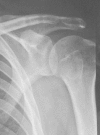Surgical treatment of chronic acromioclavicular dislocation with biologic graft vs synthetic ligament: a prospective randomized comparative study
- PMID: 23649818
- PMCID: PMC3828501
- DOI: 10.1007/s10195-013-0242-2
Surgical treatment of chronic acromioclavicular dislocation with biologic graft vs synthetic ligament: a prospective randomized comparative study
Abstract
Background: Acromioclavicular (AC) dislocation involves complete loss of articular contact; it is defined as chronic when it follows conservative management or unsuccessful surgical treatment.
Materials and methods: The study compared the clinical and radiographic outcomes of AC joint stabilization performed in 40 patients with chronic dislocation using a biological allograft (group A) or a synthetic ligament (group B). Demographic data included: M/F: 25/15; mean age: 35 ± 3.2 years; previous surgery in 11 patients, including Weaver-Dunn (3), coracoacromial ligament repair (4), stabilization with K-wires (4). Dislocation was type III in 14 (35 %) and type IV in 26 (65 %) patients. Clinical assessment was with the Constant-Murley score (pre- and postoperative) and with the modified UCLA score. Enrollment started in January 2004 and was completed in March 2008. Patients were evaluated at 1 and 4 years. Postoperative X-rays were examined to assess joint stability in the coronal and axial planes, coracoclavicular ossification, and signs of AC joint osteoarthritis and distal clavicular osteolysis.
Results: The "biological" group achieved significantly better clinical scores than the "synthetic" group at both 1 and 4 years. Poor subjective satisfaction and lower clinical scores were found in the 3 patients (1 from group A and 2 from group B) who experienced complete postoperative dislocation. No significant correlations were found with other radiographic parameters.
Conclusions: The biological graft afforded better clinical and radiographic outcomes than the synthetic ligament in patients with chronic AC joint instability. Fixation to the clavicle constitutes the main weakness of both approaches and needs improving.
Figures








References
-
- Rockwood CA. Injuries to the acromioclavicular joint. In: Rockwood CA, Green DP, editors. Fractures in adults. Philadelphia: Lippincott; 1984. pp. 860–910.
-
- Fukuda K, Craig EV, An KN, et al. Biomechanical study of the ligamentous system of the acromioclavicular joint. J Bone Joint Surg Am. 1986;68:434–440. - PubMed
-
- Rockwood CA, Jr, Williams GR, Young CD, et al. Injuries of the acromioclavicular Joint. In: Rockwood CA Jr, et al., editors. Fractures in adults. Philadelphia: Lippincott-Raven; 1996. pp. 134–1431.
-
- Bannister GC, Wallace WA, Stableforth PG, Hutson MA. The management of acute acromioclavicular dislocation. A randomised prospective controlled trial. J Bone Joint Surg Br. 1989;71:848–850. - PubMed
Publication types
MeSH terms
LinkOut - more resources
Full Text Sources
Other Literature Sources
Medical

